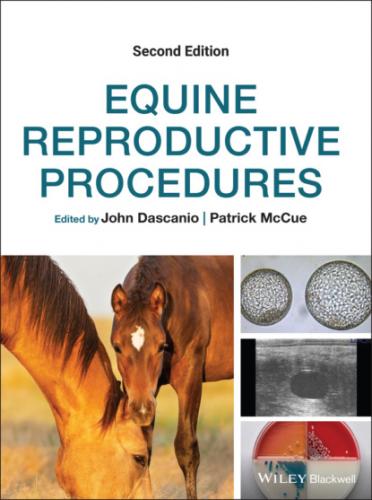The uterus of a mare in estrus will develop a characteristic “heavy” or “doughy” feel as an increase in estradiol stimulates the development of endometrial edema (Figure 7.6). After ovulation, progesterone produced by the corpus luteum results in enhanced muscular tone of the uterus, which takes on a “tubular” feel. With careful palpation, edematous folds may be detected within the uterine horns of an estral mare.
With the hand in the rectum to the level of the wrist, sweep the pelvic floor with a flat hand from a 3 o’clock to a 9 o’clock position, moving forward to about the mid forearm in the rectum until the tubular cervix is located. The cervix is best detected by flattening the hand and extending the fingers and pressing the cervix ventrally against the pelvic floor. The hand is moved back and forth laterally to evaluate cervical tone and length.
The cervix of a mare in estrus is usually short and relaxed (i.e., without tone) and may be difficult to identify per rectum. After ovulation, an elevation in progesterone results in an increase in tone and length of the cervix. The cervix of a mare in diestrus is typically 8–10 cm in length and 2–4 cm in diameter, running cranial to caudal and “rolls” under manual digital pressure.
The cervix of an older maiden mare may remain long and tight during estrus. Failure of cervical relaxation is one part of the “older maiden mare syndrome” that results in the retention of inflammatory fluid within the uterus after breeding. Evaluation of cervical morphology and detection of cervical relaxation failure is important when formulating a reproduction management plan for an older maiden mare.Figure 7.6 Palpation of the uterine horn using a cupped‐hand technique. Note that the uterine body has been cut open in this specimen to view the endometrium.
Additional Comments
It is important to learn manual palpation techniques and not just rely on imaging techniques, such as ultrasound, to evaluate the reproductive tract. Tactile differences in reproductive tissue may augment ultrasound findings.
Further Reading
1 Bowman TR. 2011. Directal rectal palpation. In: McKinnon AO, Squires EL, Vaala WE, Varner DD (eds). Equine Reproduction, 2nd edn. Ames, IA: Wiley Blackwell, pp. 1904–13.
8 Ultrasound Evaluation
Patrick M. McCue
Equine Reproduction Laboratory Colorado State University, USA
Introduction
Manual palpation should be followed by a systematic ultrasound evaluation of the entire reproductive tract. Ultrasound is used in broodmares to visualize structures in the reproductive tract that cannot be palpated or differentiated on palpation per rectum, such as detection of echogenic follicular fluid, endometrial cysts, and free fluid within the uterine lumen. In addition, ultrasonography is valuable in the early diagnosis of pregnancy, management of twins, and detection of potential ovarian or uterine pathology. Ultrasound also allows for critical evaluation of the events leading to ovulation, such as changes in follicular characteristics and grading of uterine edema.
Equipment and Supplies
Ultrasound machine, obstetrical sleeves (non‐sterile), obstetrical lubricant (e.g. carboxymethylcellulose).
Technique
Ultrasonography should be performed after manual palpation of the reproductive tract (see Chapter 7).
The rectum should be free of fecal material prior to the ultrasound examination.
Obstetrical lubricant is applied to the ultrasound probe and hand, and the probe is introduced into the rectum in the palm of the examiner’s hand.
A systematic examination of the reproductive tract should be performed. The uterus is identified in cross‐section, and the probe is slowly moved from the base of one horn to the tip of that horn while observing the ultrasound image. The probe is often held at a 30–45 degree angle from horizontal so that the cranial tip of the probe is lower than the caudal part of the probe. The uterus is thus held between the probe and the body wall or pelvis for scanning.
The probe is then manipulated to allow for complete visualization of the ovary ipsilateral to the uterine horn just examined.
After the ovarian exam is completed, the ipsilateral horn tip is again identified and the probe is slowly passed distally along the uterine horn to the uterine bifurcation and then proximally up the opposite uterine horn (Figure 8.1).
The position of the probe is again adjusted to evaluate the second ovary before descending back down the adjacent uterine horn.
The final evaluation is of the uterine body, which is usually visualized in a longitudinal plane with a linear transducer.Figure 8.1 Technique for ultrasound examination of the mare reproductive tract. A linear array transducer is shown over the uterine horn. Note that the uterine body has been cut open in this specimen to view the endometrium.Figure 8.2 Ovarian follicles. The larger follicle is developing a thickened echogenic border (arrow).
The entire reproductive tract should be examined in one continuous motion, avoiding disruption in visualization of any part of the tract. Small embryonic vesicles or small areas of pathology may be missed if a continuous scan of the reproductive tract is not performed.
Figure 8.3 Corpus hemorrhagicum (arrow). The interior of the former follicular lumen is filled with echogenic material (i.e., clotted blood).
Figure 8.4 Mature corpus luteum (arrow) consisting of a solid structure of uniform echogenicity.
Figure 8.5 Regressing corpus luteum (arrow).
Interpretation
Ovarian Ultrasound Features
Normal ovarian structures routinely observed with ultrasound are various sizes of ovarian follicles, fresh ovulations, corpora hemorrhagica, corpora lutea, and regressing corpora albicans (Figures ). Ovarian follicles contain clear follicular fluid, which results in a black image on ultrasound. Ovulation is initially detected as the absence of a previously noted large follicle in a mare in estrus. After ovulation, the follicle fills up with blood, forming the corpus hemorrhagicum. This structure is detected as a homogenous,
